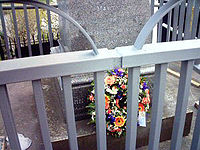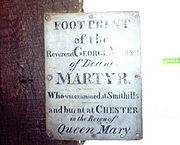.gif)
George Marsh (martyr)
Encyclopedia

Martyr
A martyr is somebody who suffers persecution and death for refusing to renounce, or accept, a belief or cause, usually religious.-Meaning:...
who was born in the parish of Deane
Deane, Greater Manchester
Deane is an area of Bolton, in Greater Manchester, England. It is about south west of Bolton and northwest of the city of Manchester.Historically a part of Lancashire, the Parish of Deane was once one of four parishes within the hundred of Salford and covered roughly half of the present...
, near Bolton
Bolton
Bolton is a town in Greater Manchester, in the North West of England. Close to the West Pennine Moors, it is north west of the city of Manchester. Bolton is surrounded by several smaller towns and villages which together form the Metropolitan Borough of Bolton, of which Bolton is the...
in 1515. He died in Boughton
Boughton, Cheshire
Boughton is a neighbourhood to the east of Chester city centre, part of the unitary authority of Cheshire West and Chester and the ceremonial county of Cheshire, England...
, Chester
Chester
Chester is a city in Cheshire, England. Lying on the River Dee, close to the border with Wales, it is home to 77,040 inhabitants, and is the largest and most populous settlement of the wider unitary authority area of Cheshire West and Chester, which had a population of 328,100 according to the...
on 24 April 1555 as a result of the Marian Persecutions
Marian Persecutions
The Marian Persecutions were carried out against religious reformers, Protestants, and other dissenters for their heretical beliefs during the reign of Mary I of England. The excesses of this period were mythologized in the historical record of Foxe's Book of Martyrs...
which were carried out against religious reformers, Protestants, and other dissenter
Dissenter
The term dissenter , labels one who disagrees in matters of opinion, belief, etc. In the social and religious history of England and Wales, however, it refers particularly to a member of a religious body who has, for one reason or another, separated from the Established Church.Originally, the term...
s for their beliefs during the reign of Mary I of England
Mary I of England
Mary I was queen regnant of England and Ireland from July 1553 until her death.She was the only surviving child born of the ill-fated marriage of Henry VIII and his first wife Catherine of Aragon. Her younger half-brother, Edward VI, succeeded Henry in 1547...
. His death is recorded in Foxe's Book of Martyrs
Foxe's Book of Martyrs
The Book of Martyrs, by John Foxe, more accurately Acts and Monuments, is an account from a Protestant point of view of Christian church history and martyrology...
.
Life


Mary I of England
Mary I was queen regnant of England and Ireland from July 1553 until her death.She was the only surviving child born of the ill-fated marriage of Henry VIII and his first wife Catherine of Aragon. Her younger half-brother, Edward VI, succeeded Henry in 1547...
. After Saunders was arrested George Marsh came north and continued preaching the Protestant faith in the parishes of Deane, Eccles
Eccles, Greater Manchester
Eccles is a town in the City of Salford, a metropolitan borough of Greater Manchester in North West England, west of Salford and west of Manchester city centre...
and elsewhere in Lancashire
Lancashire
Lancashire is a non-metropolitan county of historic origin in the North West of England. It takes its name from the city of Lancaster, and is sometimes known as the County of Lancaster. Although Lancaster is still considered to be the county town, Lancashire County Council is based in Preston...
. Justice Barton of Smithills Hall
Smithills Hall
Smithills Hall is a Grade I listed manor house, and a Scheduled Monument in the township of Halliwell, now in Bolton, Greater Manchester, England. it stands on the slopes of the moors above Bolton at a height of 500 feet, two miles north west of the town centre. It occupies a defensive site near...
, Bolton sent servants to arrest him at his mother's house but he gave himself up at Smithills Hall. After being "examined" at Smithills, according to local tradition, George Marsh stamped his foot so hard to re-affirm his faith, that a footprint was left in the stone floor.
He refused to convert to Catholicism
Catholicism
Catholicism is a broad term for the body of the Catholic faith, its theologies and doctrines, its liturgical, ethical, spiritual, and behavioral characteristics, as well as a religious people as a whole....
; he was even given one last chance to convert while being tied to the stake at which he would be burned.
Death

There is no grave marker in the Cemetery erected for him just a brief footnote on an inscription:
- "St Giles Cemetery. Here stood the leper hospital and chapel of St Giles. Founded early in the 12th century and endowed by successive Norman earls of Chester they remained in constant use until 1643. When defensive measures during the siege of Chester necessitated the demolition of buildings outside the city walls. The cemetery remained to mark the site and in time the little village of Spital Boughton clustered around it. In 1644 the royalist defenders suffered great loss of life in a gallant sortie in Boughton and many of the fallen were buried here. It was also used for victims of the plagues which ravaged the city in the 16th and 17th centuries. Being extra parochial the site was granted to the corporation by Charles II in 1685. As a burial ground and through for a period in the charge of St Johns parish. It remains in their hands. When Protestant martyr George Marsh was burned at the stake on gallows hill close by his ashes were collected by his friends and buried here. The last burial took place in 1854"
Memorials

St John the Baptist's Church, Chester
St John the Baptist's Church, Chester is in the city of Chester, Cheshire, England. It lies outside the city walls on a cliff above the north bank of the River Dee. It has been designated by English Heritage as a Grade I listed building. It is an active Anglican parish church in the diocese...
and the other is by the road side in Boughton which contains the following inscription:
"George Marsh born Dean Co. Lancaster. To the memory of George Marsh martyr who was burned to death near this spot for the truth sake April 24th 1555. Also John Plessington 19th July 1679. Canonised saint 25th October 1970."
There are two memorials to George Marsh at St Mary's Church, Deane. The base of a memorial cross in the churchyard is said to have been the base of an ancient Saxon cross from which early Christian preachers taught. It originally stood half a mile to the west of the church on Broadgate Road. Inscriptions on the base record his martyrdom and the erection of the memorial in 1893. A window was also dedicated to him in 1897. It depicts Faith, Charity and Hope.
Present day
The execution of George Marsh is still remembered by Protestants in Chester. They recently held a commemoration for him outside the Town HallChester Town Hall
Chester Town Hall is in Northgate Street in the centre of the city of Chester, Cheshire, England. It has been designated by English Heritage as a Grade II* listed building.-History:...
.

External links
- PetrosomatoglyphPetrosomatoglyphA petrosomatoglyph is an image of parts of a human or animal body incised in rock. Many were created by Celtic peoples, such as the Picts, Scots, Irish, Cornish, Cumbrians, Bretons and Welsh. These representations date from the Early Middle Ages; others of uncertain purpose date back to megalithic...
- Christian Heritage

